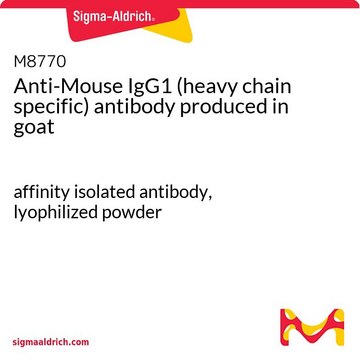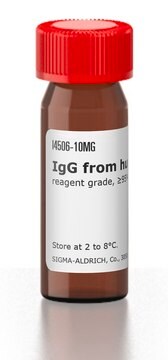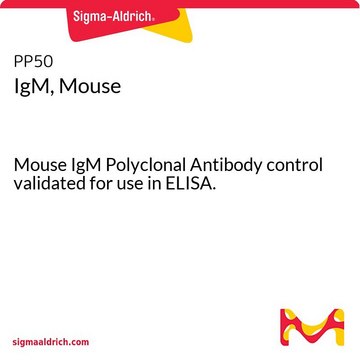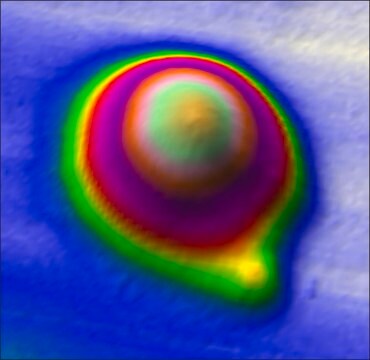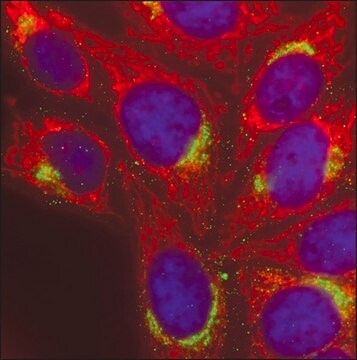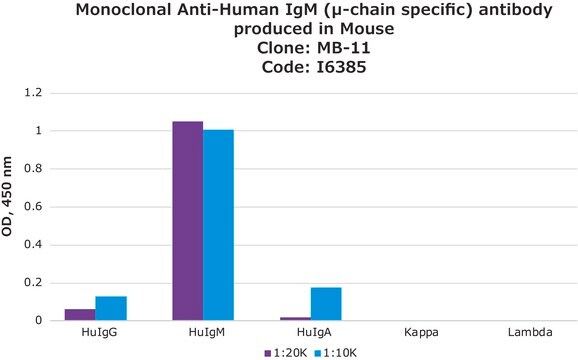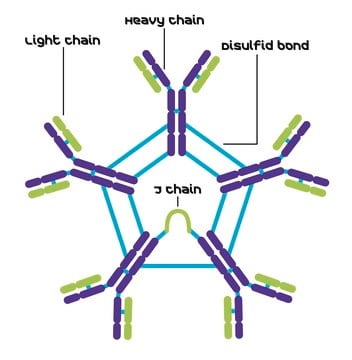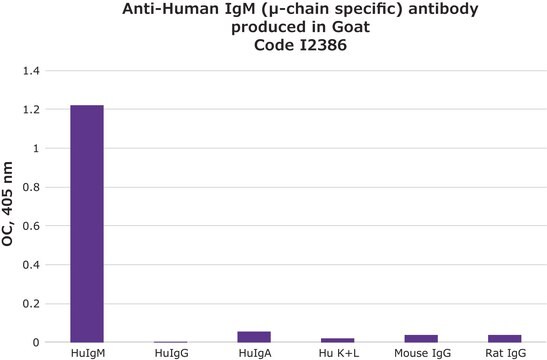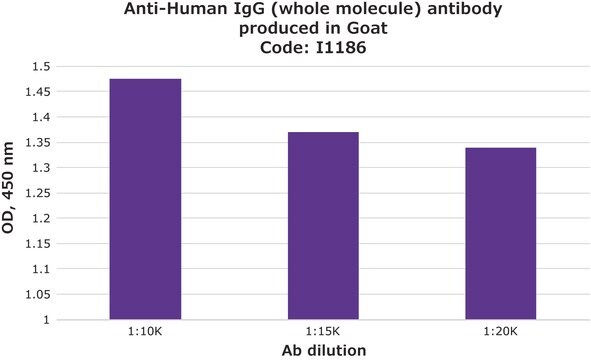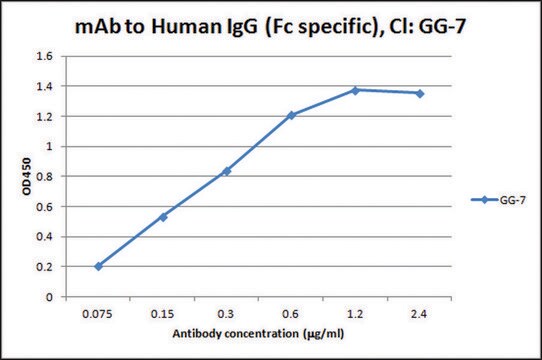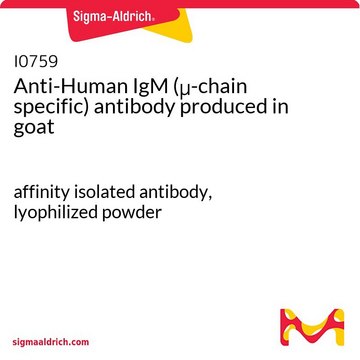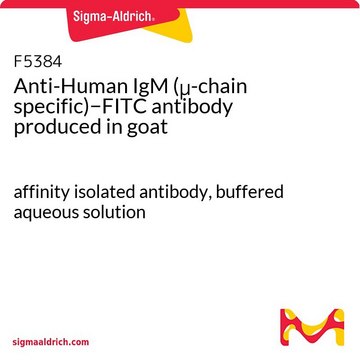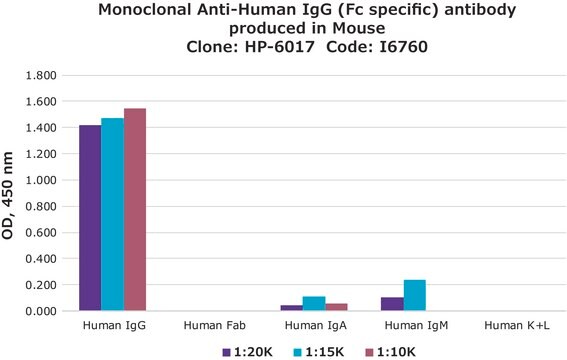SAB4700346
Monoclonal Anti-IgM antibody produced in mouse
clone CH2, purified immunoglobulin, buffered aqueous solution
Se connecterpour consulter vos tarifs contractuels et ceux de votre entreprise/organisme
About This Item
Code UNSPSC :
12352203
Nomenclature NACRES :
NA.46
Produits recommandés
Source biologique
mouse
Niveau de qualité
Conjugué
unconjugated
Forme d'anticorps
purified immunoglobulin
Type de produit anticorps
primary antibodies
Clone
CH2, monoclonal
Forme
buffered aqueous solution
Espèces réactives
human
Concentration
1 mg/mL
Technique(s)
flow cytometry: suitable
Isotype
IgG1
Numéro d'accès NCBI
Conditions d'expédition
wet ice
Température de stockage
2-8°C
Modification post-traductionnelle de la cible
unmodified
Informations sur le gène
human ... IGH@(3492)
Description générale
Immunoglobulin M (IgM) is a member of immunoglobulin family. It exists as a pentamer in the serum and has a high molecular weight. Monomeric IgM has a molecular weight of 190 kDa. The pentameric IgM is characterized with ten μ heavy chains, ten light chains and a single J-chain which is linked by disulphide bonds. The μ chain consists of five domains- VH, Cμ1, Cμ2, Cμ3 and Cμ4. Limited digestion using papain cleaves the antibody into three fragments, two of which are identical and contain the antigen-binding activity. They are known as fragment antigen binding (Fab) fragments. The third fragment does not possess antigen-binding activity and is known as fragment crystallizable (Fc). It interacts with cells and effector molecules. The heavy chains of IgM contain an extra C domain that replaces the hinge region. IgM is the first antibody to be produced during an immune response and is the major isotype secreted in T-cell independent immune responses.
The antibody CH2 reacts with Fc fragment of human IgM.
Immunogène
Purified human IgM
Application
The reagent is designed for Flow Cytometry analysis. Suggested working dilution for Flow Cytometry is 1 μg/mL of sample. Indicated dilution is recommended starting point for use of this product. Working concentrations should be determined by the investigator.
Caractéristiques et avantages
Evaluate our antibodies with complete peace of mind. If the antibody does not perform in your application, we will issue a full credit or replacement antibody. Learn more.
Forme physique
Solution in Tris buffered saline, pH 8.0, with 15 mM sodium azide.
Clause de non-responsabilité
Unless otherwise stated in our catalog or other company documentation accompanying the product(s), our products are intended for research use only and are not to be used for any other purpose, which includes but is not limited to, unauthorized commercial uses, in vitro diagnostic uses, ex vivo or in vivo therapeutic uses or any type of consumption or application to humans or animals.
Vous ne trouvez pas le bon produit ?
Essayez notre Outil de sélection de produits.
Code de la classe de stockage
10 - Combustible liquids
Classe de danger pour l'eau (WGK)
WGK 1
Point d'éclair (°F)
Not applicable
Point d'éclair (°C)
Not applicable
Faites votre choix parmi les versions les plus récentes :
Déjà en possession de ce produit ?
Retrouvez la documentation relative aux produits que vous avez récemment achetés dans la Bibliothèque de documents.
Les clients ont également consulté
The structure of a typical antibody molecule
Immunobiology: The Immune System in Health and Disease (2001)
Structural variation in immunoglobulin constant regions
Immunobiology: The Immune System in Health and Disease (2001)
D Martins de Medeiros et al.
Lupus, 23(13), 1412-1416 (2014-06-26)
The objective of this report is to conduct short- and long-term evaluation of a large panel of antiphospholipid (aPL) autoantibodies following pandemic influenza A/H1N1 non-adjuvant vaccine in primary antiphospholipid syndrome (PAPS) patients and healthy controls. Forty-five PAPS and 33 healthy
Andi Krumbholz et al.
Medical microbiology and immunology, 203(4), 273-282 (2014-04-20)
An increase in acute autochthonous hepatitis E virus (HEV) infections has been recorded in Germany. These are suspected to be zoonotically transmitted from wild boar, deer and domestic pig. The latter may represent a major reservoir for HEV. In this
Rosane Oliveira et al.
Journal of medical microbiology, 63(Pt 9), 1119-1130 (2014-06-15)
Leptospirosis, a worldwide zoonotic infection, is an important human and veterinary health problem. We have previously identified a leptospiral multipurpose adhesin, Lsa66, capable of binding extracellular matrix (ECM) components and plasminogen (PLG). In this work, we report the cloning, expression
Notre équipe de scientifiques dispose d'une expérience dans tous les secteurs de la recherche, notamment en sciences de la vie, science des matériaux, synthèse chimique, chromatographie, analyse et dans de nombreux autres domaines..
Contacter notre Service technique